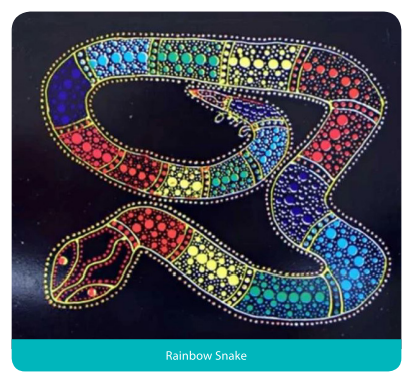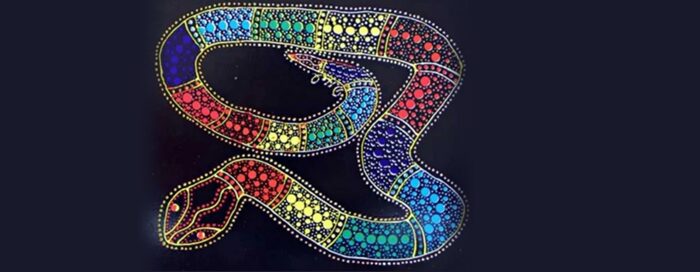According to Aboriginal legend a giant rainbow snake formed the main rivers throughout Australia when he slithered across the land in search of water. The water in Australia is said to be blessed by the Rainbow Serpent, as water is one of the necessities of life. Without the Great Artisian Basin, a body of water under the Australian Earth, opal would not have been formed. There are therefore great connections between the Rainbow Serpent and the opals of Australia.

Opals are truly mesmerizing treasures of the earth, the way their vibrant colours dance with the light. Australia has been the main producer of opals since the 19th century. Opal is a hardened silica gel composed of tiny silica spheres and the stunning iridescence seen in opal is caused by the way these little spheres interact and diffract light. The larger the spheres the greater the range of colours.
Many people believe opals to be unlucky because it is quite common for opal stones to fall out of their setting and be lost. However, this is not because of some great curse, it is due to the fact that opals are composed of 5-10% water and over time they can dry out and shrink and therefore become loose and fall out of jewellery settings.
The major mines in Australia can be found in Queensland, New South Wales, and South Australia. When valuing and grading an opal it needs to be assessed under the correct light source. It needs to be examined holistically – face up but also underneath, if the setting allows, so that any defects, holes, and fractures can be taken into consideration. The following factors determine the value: the opal type – i.e. solid black, grey, white, crystal type, The origin, body tone, play of colour, colour depth percentage, colour pattern, shape, cut, polish, weight, dimensions, visual inclusions, condition, and provenance.
One of the most famous Australian opals is The Aurora Australis. It was discovered in 1938 in Lighting Ridge (NSW) in an old seabed. Its body colour is black which highlights the dramatic play of colour of intense blues, greens, and reds. It got its name because it resembled the brightness of the Southern Lights. It weighs 180cts and has been cut and polished into an oval shape. It is said to be worth an estimated $1,000,000 AUD.

Opal can also be found in other countries such as Ethiopia, USA and Mexico, however Australian opal is considered the finest. As with most gemstones there are many synthetic opals and opals that have been artificially enhanced on the market. Slocum stone is a man-made glass that imitates the play of colour in opal. Gilson imitation opal has a very defined mosaic pattern which can be detected under magnification that is said to resemble chicken wire.
Black opal is the most highly prized and valuable, however before purchasing the consumer should be aware of treatments such as ‘smoking’. The opal is wrapped in paper and the paper is heated to a temperature that makes it smoulder. The smouldering paper then releases fine black particles of soot that enter the pores of the opal and darken its body colour.
The darker body colour contrasts with the opal’s play-of-colour, making it appear stronger and more obvious. Many Ethiopian opals are smoked and consequently are less valuable. The question is can you tell the difference?
“In precious opals there might be a dash of red here, a seductive swirl of blue there, and in the center, perhaps, a flirtatious glance of green. But each stone flickers with a unique fire and a good opal is one with an opinion of its own.” Victoria Finlay









